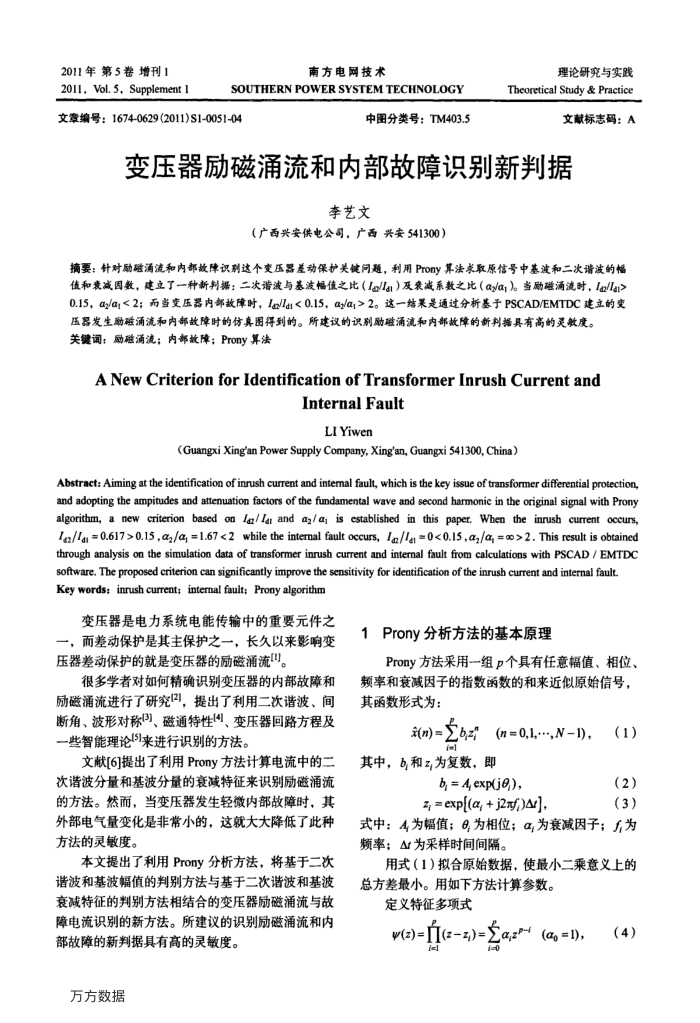您当前的位置:首页>论文资料>变压器励磁涌流和内部故障识别新判据
内容简介
 2011年第5卷增刊1
2011年第5卷增刊12011.Vol.5.Supplement1
南方电网技术
SOUTHERNPOWERSYSTEMTECHNOLOGY
文章编号:1674-0629(2011)S1-0051-04
中图分类号:TM403.5
理论研究与实践
Theoretical Study & Practice
文献标志码:A
变压器励磁涌流和内部故障识别新判据
李艺文
(广西兴安供电公司,广西兴安541300)
摘要:针对励磁涌流和内部故障识别达个变压器差动保护关键问题,利用Prony算法求取原信号中基波和二次谐波的幅值和表减因数,建立了一种新判据:二次谐波与基波幅值之比(Ia/la)及衰减系数之比(αz/a;)。当励碰涌流时,lz/la> 0.15,az/ai<2;而当变压器内部故障时,Ia/lal<0.15,az/aj>2。这一结采是通过分析基于PSCAD/EMTDC建立的变
压器发生励磁涌流和内部故障时的仿真图得到的。所建议的识别励磁涌流和内部故障的新判据具有高的灵敏度。关键词:励磁涌流;内部故障;Prony算法
ANewCriterionforIdentificationofTransformerInrushCurrentand
InternalFault LIYiwen
(Guangxi Xingan Power Supply Company, Xingan, Guangxi 541300, China)
Abstract: Aiming at the identification of inrush current and intemal fault, which is the key issue of transformer differential protection, and adopting the ampitudes and attenuation factors of the fundamental wave and second harmonic in the original signal with Prony algorithm, a new criterion based on Ia/ lar and az/a; is established in this paper. When the inrush current occurs, Igz/la, = 0.617 > 0.15 , α, /a, =1.67 <2 while the internal fault occurs, Ig/lg, = 0<0.15, a,/α, = co >2. This result is obtained through analysis on the simulation data of transformer inrush current and internal fault from calculations with PSCAD / EMTDC
software. The proposed criterion can significantly improve the sensitivity for identification of the inrush current and internal fault Key words: inrush current; intermal fault; Prony algorithm
变压器是电力系统电能传输中的重要元件之而差动保护是其主保护之一,长久以来影响变
压器差动保护的就是变压器的励磁涌流["]。
很多学者对如何精确识别变压器的内部故障和励磁涌流进行了研究(),提出了利用二次谐波、间断角、波形对称(3)、磁通特性围、变压器回路方程及一些智能理论3)来进行识别的方法。
文献[6]提出了利用Prony方法计算电流中的二次谐波分量和基波分量的衰减特征来识别励磁涌流的方法。然而,当变压器发生轻微内部故障时,其外部电气量变化是非常小的,这就大大降低了此种方法的灵敏度。
本文提出了利用Prony分析方法,将基于二次
谐波和基波幅值的判别方法与基于二次谐波和基波衰减特征的判别方法相结合的变压器励磁涌流与故障电流识别的新方法。所建议的识别励磁涌流和内
部故障的新判据具有高的灵敏度。万方数据
1Prony分析方法的基本原理
Prony方法采用一组p个具有任意幅值、相位、频率和衰减因子的指数函数的和来近似原始信号,其函数形式为:
-小
(n=0,I,..,N1).
其中,b,和z,为复数,即
b, =A,exp(jo,),
z,=exp[(a, +j2f,)]
(1)(2)(3)
式中:4为幅值;§,为相位;a,为衰减因子;为频率;At为采样时间间隔。
用式(1)拟合原始数据,使最小二乘意义上的总方差最小。用如下方法计算参数。
定义特征多项式
(2)= (z -z,) =
fl
Ca,zP-f
(ao =1),
io
(4)